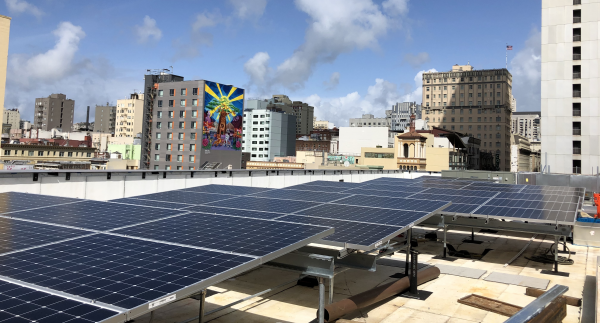Have you ever wondered how solar panels capture energy from the sun to produce electricity? Or perhaps you want to learn how to get the most power output of your own PV array? Read on to learn how solar panels produce electricity, or if you are simply interested in learning how to optimize your solar system skip down to that section.
How Solar Panels Work
How do your solar panels generate electricity? Magic? Not quite. Solar cells are made up of a silicon sandwich whose elemental structure makes silicon ideal for converting light to energy. The top layer of the sandwich is doped with electrons generating a net negative charge (n-type) while the bottom layer has a lack of electrons, called holes, producing a net positive charge (p-type). As seen in the figure below, when a wave of sunlight hits the PV cell the photon transfers its energy to an electron in the silicon element, effectively knocking it loose. Unable to cross the junction, (depicted as a blue line in the figure below) the electron makes its way to the conductive wiring at the top of the panel. It then generates a current by traveling through the circuit back to the positively charged bottom layer. Ultimately, this process will continue unless there is break in your circuit or the sun is down.

Figure 1. How Solar Panels Work, created by Allie Periman
But wait, if all it requires is light for the electron to break free, why can’t I simply shine a light on my PV array so I get power all the time? Shining a light on your array is ineffective and less efficient than sunlight. The light hitting the array must be between 400 nm and ~700 nm for the electron/photon interaction to occur. As seen in the image below, solar radiation spans the entirety of that region. Different types of artificial light emit wavelengths at various intensities as shown in the figure below. The intensity and spectrum of daylight provides the optimal light source for generating electricity. Not to mention, the array can only generate as much electricity as it takes in. This means the array would only produce enough energy to light the bulb that is shining on it!

Figure 2. How Natural Light Differs from Artificial Light, courtesy of Sunlight Inside
Now that we understand the basics of how solar arrays work, we can develop strategies for optimizing our own systems. To optimize, we will target the components that affect energy output and identify ways to increase the efficiency of the panels.
Strategies for Optimizing your PV Array
1. Buy Higher-Efficiency Solar Panels
Independent of the incoming solar, the efficiency of a cell is affected by factors like the manufacturing quality, electrical configuration, and ambient air temperature. Solar cell efficiency ranges between 11% to 23% efficient. To put this in perspective, a high efficiency panel that is 21.2% efficient may provide up to 1.1 more kilowatts of solar capacity compared with a 16.5% efficient panel. According to Clean Energy Reviews, the higher efficiency system will be closer to $300 verses $100 per panel. Though there would be a higher upfront cost, the energy savings down the road may make it a worthy investment.
2. Monitor your System Output
When you regularly monitor the electric output from the solar array you can catch issues early. Many energy monitoring systems have the capability of doing this, so check your energy monitor for this integration or the website before buying your next energy monitor. The table linked here shows options for energy monitor’s that accommodate solar monitoring.
3. Clean Solar Panels to Maximize Efficiency
Excluding material configuration, PV electric output depends on the amount of energy coming into the system. Clean and unobstructed panels will maximize the amount of light coming in to knock electrons free. Ensuring your array is free of dirt, grime and snow build up will increase your efficiency. In some cases, natural rain fall will be sufficient in maintaining clean panels, but if you live in a location with minimal rainfall, it may be beneficial to carefully clean your panels up to twice a year.
4. Connect Microinverters to Each Panel
Have you ever had one leaf shade a single panel on your array and your entire array goes out? Your panels might be connected in series to one inverter. Microinverter systems tend to be about 20%-30% more expensive than a standard system, but if you are finding your panels going down frequently, you may consider installing them. Inverters are required in any solar array to convert the outputted DC current to usable AC current. A microinverter does the same thing but on a smaller scale for each panel. Voila! You now have usable electricity produced per panel. It is important to note that microinverters are not the catch all solution and a similar strategy, as mentioned previously, may be to closely monitor your system to catch obstructions early.
5. Battery Storage
Energy storage is the crux of any solar system. Introduce a battery to your solar system, and you have an energy supply when the sun isn’t shining. A handful of companies like All Terra Solar, Custom Power Solar, and Sandbar Solar (listed in the table below) have developed energy storage options to optimize your system. In California, with solar energy storage becoming increasingly available and high grid demand, batteries are an easy step towards making your home more resilient.
Understanding the basics of how photovoltaic reactions occur to produce electricity helps us develop strategies for optimizing our own system. If you are interested in installing solar panels or upgrading your own system, here is a list of companies that we have partnered with or are familiar with to get you started!






























